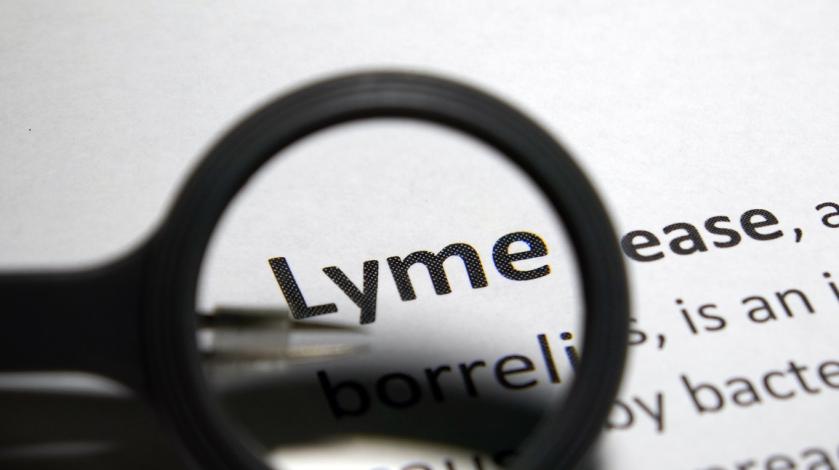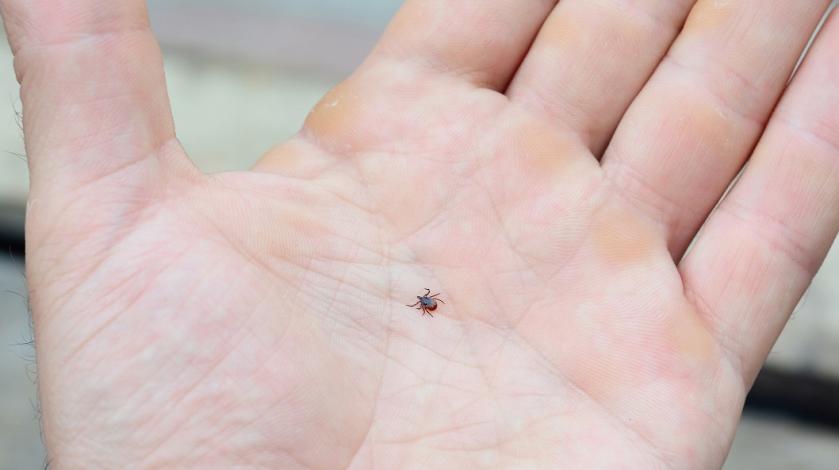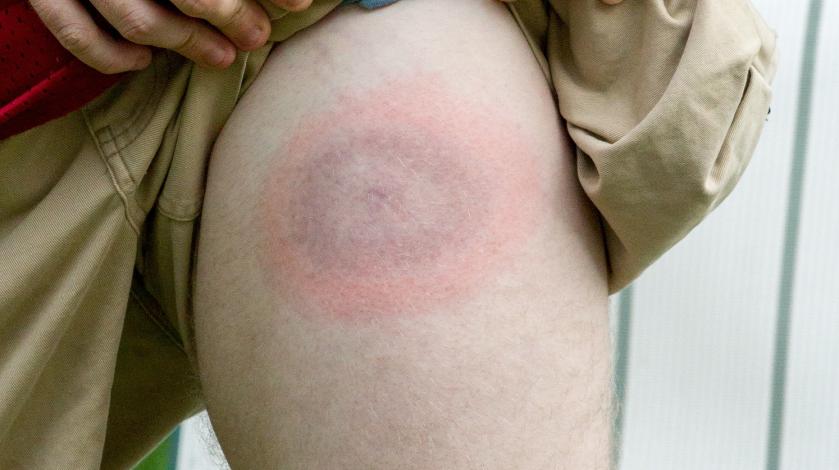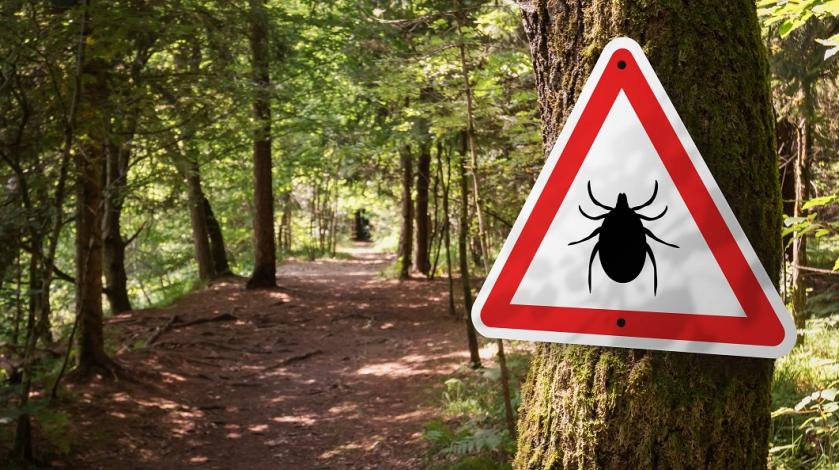
June 28, 2023 By Todd Ellerin, MD, Director of Infectious Disease
Another mild winter in the Northeast helped kick tick season off early, and health officials will be watching to see if that leads to an uptick in Lyme Disease and other tick-borne illnesses.
The most common vector-borne illness in the U.S., Lyme disease is caused by the bacteria Borrelia burgdorferi and is transmitted through the bite of a blacklegged tick – also known as the deer tick.
Prevalent throughout the Northeast and mid-Atlantic regions and upper Midwest, blacklegged ticks and the illnesses they carry are expanding into other regions of the country, leading to an increase in Lyme disease cases.
More than 30,000 cases of Lyme disease are reported to the Centers for Disease Control and Prevention (CDC) annually by state health departments. In 2019 – the most recent year of statistics available from the CDC’s National Notifiable Disease Surveillance System (NNDSS) – there were 34,945 cases of Lyme disease reported (23,453 confirmed, 11,492 probable).
But those figures don’t account for all Lyme cases. According to the CDC, as many as 476,000 people contract Lyme disease in the U.S. each year.
To learn more, we asked Todd Ellerin, MD, Director of Infectious Disease at South Shore Health six questions about Lyme disease.

At what time of year are people at greatest risk of contracting Lyme disease?
Tick season and the risk of Lyme disease generally runs from April through October, but may last longer depending on the climate. Wet weather and warmer temperatures can keep ticks active longer in the year.
Most Lyme disease cases are reported from May through August, which corresponds with the time of peak activity for young ticks, known as nymphs. Adult ticks are most active in early spring and fall.
Nymph ticks can pose a bigger risk for transmitting disease because they are smaller, (about the size of a poppy seed) and difficult to see and quickly remove.
Ticks must be attached for 36-48 hours before the Lyme disease bacterium can be transmitted. Finding and removing a tick within 24 hours significantly reduces the chances of getting Lyme disease.

What are the symptoms of Lyme disease and how long do they last?
Lyme disease symptoms can include headache, swollen lymph nodes, fever, fatigue, chills, joint and muscle aches and a skin rash known as erythema migrans (EM).
About 70-80 percent of Lyme disease cases present with the EM rash, which generally appears within 3-30 days (the average is 7 days) at the site of the tick bite. While it may feel warm, the rash is not generally painful or itchy.
After it appears, an EM rash may gradually grow large in size (more than 5-10 centimeters) and then take on the look of a bull’s eye as it begins to clear.
Tick bites often lead to tiny dime-sized areas of erythema, which appear like a small red circle – some of which have a pale center. This is caused by the saliva of a tick and is not erythema migrans. If this area of erythema grows to at least 5 centimeters (the size of the palm of your hand), you should seek medical attention.
Most Lyme disease cases can be treated successfully with antibiotics within 2-4 weeks. But if left untreated the infection can spread to the joints, heart and nervous system causing arthritis, severe headaches, facial palsy, heart palpitations or an irregular heart beat known as Lyme carditis, inflammation of the brain and spinal cord, nerve pain, dizziness and shortness of breath.
What is post-treatment Lyme Disease Syndrome?
In some patients, Lyme disease symptoms including fatigue, body aches, nerve pain and difficulty concentrating (brain fog) persist for more than six months after treatment. This is called Post-Treatment Lyme Disease Syndrome (PTLDS).
While it is not clear why some people experience PTLDS, some health care experts think the bacterium Borrelia burgdorferi triggers an autoimmune response allowing symptoms to persist even after the infection is gone. Other theories include the existence of another, hard-to-detect infection, or that the symptoms are due to causes unrelated to the Lyme disease infection.
Symptoms of PTLDS are similar to those experienced by patients with myalgic encephalomyelitis/chronic fatigue syndrome (ME/CFS) and post-acute sequelae of SARS CoV-2 infection (PASC) – also known as long COVID. Like long COVID and ME/CFS, there is no proven cure for PTLDS but some symptoms can be managed and most patients get better over time.

How is Lyme disease identified and why is it sometimes difficult to diagnose?
The fact that Lyme disease symptoms are similar to those of other conditions and illnesses can make it difficult to diagnose.
After assessing patients’ symptoms and determining whether they have been exposed to infected blacklegged ticks, there is a two-step laboratory test for Lyme disease using the same blood sample.
If the first step is negative for Lyme disease, no further testing is needed. If the first test is positive or indeterminate, the second should be done.
The test is designed to detect antibodies generated in response to infection, but antibodies may take weeks to develop, therefore patients recently infected may test negative. Infection with other viral, bacterial or autoimmune diseases can also result in false positive results.
What are the treatments for Lyme disease and is there a vaccine?
Antibiotic medications including Doxycycline, Amoxicillin and Cefuroxime are used to treat early Lyme disease.
In cases (prior to a Lyme diagnosis), in which a deer tick is attached to a person for more than 36 hours, antibiotics (single dose doxycycline 200 mg) can be prescribed prophylactically. This is not recommended for pregnant women and children under 8 years old. For these patients, observation without antibiotic prophylaxis is advised. The risk of Lyme in these cases is roughly 3% so the vast majority of people who get tick bites do well without any treatment.
The Lyme disease vaccine LYMERix developed by SmithKline Beecham was pulled from the market more than 20 years ago due to low consumer demand stemming from reports of adverse reactions and anti-vaccine sentiment.
But according to a recent article in Axios, new Lyme disease vaccines are in the pipelines of drug makers Moderna and Pfizer in a partnership with Valneva.
Moderna has announced the development of two novel mRNA vaccine candidates and Pfizer/Valneva are in late stage clinical trials and enrolling participants for its VLA15 vaccine. Both companies could apply for FDA authorization by 2025.

How can I protect myself against Lyme disease?
Reducing your exposure to ticks is the best way to protect yourself from Lyme disease and other tick-borne illness.
Ticks live in grassy, brushy and wooded places, so by avoiding these areas you can avoid tick bites. If you are heading outdoors for a hike, stick to the center of trails, away from high grass and leaf litter.
Cover up and limit your exposed skin by wearing pants and long sleeves and use bug spray that repels ticks. The CDC recommends using a bug spray that contains DEET 30% or picaridin. Repellent with oil of lemon eucalyptus is also effective.
Treat your clothing, boots and camping gear with products containing 0.5% permethrin. Permethrin repels ticks and remains protective on clothing and gear through several washings.
Once indoors, check your clothing and body and your pets for ticks, and remove them immediately. Showering soon after being outdoors may reduce your risk by washing off unattached ticks.
It also provides an opportunity to do a thorough tick check, focusing in and around the hair, the ears, under the arms, between your legs, behind your knees, and inside your belly button.
Removing ticks quickly (within 24 hours) greatly reduces the risk of getting Lyme disease.

